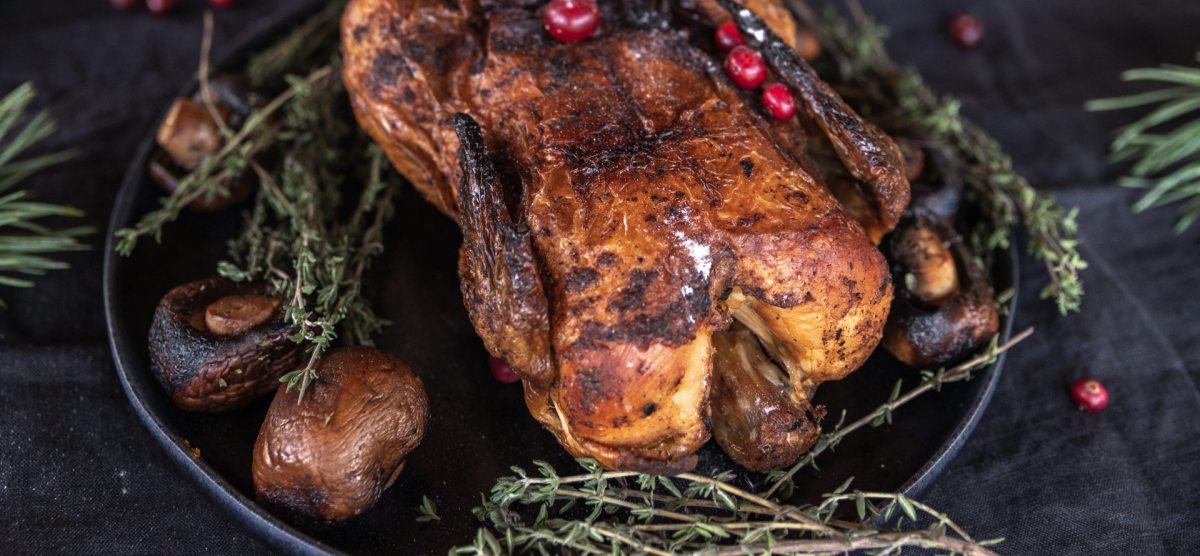Imagine a Christmas feast brimming with rich flavors and festive cheer, yet entirely Paleo-friendly. Forget the sugar-laden desserts and processed side dishes; this guide unveils the secrets to crafting a celebratory meal that’s both delicious and nourishing. From succulent main courses like a perfectly roasted turkey or a flavorful prime rib, to vibrant side dishes bursting with seasonal vegetables and inventive Paleo desserts that satisfy every sweet craving, we’ll lead you through each step, ensuring a memorable and healthy Christmas celebration.
This comprehensive guide provides detailed recipes, step-by-step instructions, and time-management strategies to navigate the preparation of a complete Paleo Christmas feast. We’ll explore various Paleo-friendly options for each course, compare their nutritional profiles, and offer helpful tips and substitutions to customize the menu to your preferences and dietary needs. Get ready to elevate your Christmas dinner to a new level of deliciousness and health.
Paleo Main Course Options

A Paleo Christmas feast demands main courses that are both celebratory and adhere to the principles of the Paleo diet. This means focusing on nutrient-rich, whole foods free from grains, legumes, and refined sugars. The following options provide delicious and satisfying choices for your festive meal.
Paleo Roasted Turkey with Herb Butter
This classic Christmas centerpiece gets a Paleo makeover with a flavorful herb butter and careful roasting technique. The result is a juicy, tender turkey with crispy skin, perfect for sharing.
- Preparation: Begin by patting a 12-14 pound organic, free-range turkey dry with paper towels. Mix 1/2 cup softened unsalted butter with 2 tablespoons fresh rosemary, 1 tablespoon fresh thyme, 1 tablespoon sage, 1 teaspoon salt, and 1/2 teaspoon black pepper. Gently loosen the skin from the breast and legs, and spread the herb butter evenly underneath. Place the turkey in a roasting pan.
- Roasting: Preheat your oven to 325°F (160°C). Roast the turkey uncovered for approximately 3-4 hours, or until a meat thermometer inserted into the thickest part of the thigh registers 165°F (74°C). Baste the turkey with pan juices every 30 minutes for added moisture and flavor. For extra crispy skin, increase the oven temperature to 400°F (200°C) for the last 30 minutes of cooking.
- Resting: Once cooked, remove the turkey from the oven and let it rest for at least 20 minutes before carving. This allows the juices to redistribute, resulting in a more tender and flavorful bird.
Prime Rib Roast with Garlic and Rosemary
A show-stopping prime rib roast is a luxurious Paleo option. The rich marbling of the beef provides incredible flavor and tenderness.
- Preparation: Choose a 3-4 pound bone-in prime rib roast. Pat it dry with paper towels. Rub the roast generously with 4 cloves minced garlic, 2 tablespoons fresh rosemary, 2 teaspoons salt, and 1 teaspoon black pepper. Let it sit at room temperature for at least 30 minutes to allow the flavors to meld.
- Roasting: Preheat your oven to 450°F (230°C). Sear the prime rib in a hot cast-iron skillet for 2-3 minutes per side to develop a beautiful crust. Transfer the roast to a roasting pan and roast for 20 minutes. Reduce the oven temperature to 325°F (160°C) and continue roasting for an additional 15-20 minutes per pound, or until a meat thermometer inserted into the thickest part registers 130-135°F (54-57°C) for medium-rare.
- Resting: Remove the roast from the oven and let it rest for at least 20 minutes before carving. This allows the juices to redistribute, ensuring a tender and flavorful roast.
Slow-Cooked Paleo Ham
A slow-cooked ham provides a moist and flavorful alternative, perfect for a less hands-on approach.
- Preparation: Choose a bone-in, spiral-sliced ham (ensure it’s free of added sugars and preservatives). Place the ham in a large slow cooker. Add 1 cup of bone broth or water to the bottom of the slow cooker.
- Slow Cooking: Cook on low for 6-8 hours, or until the internal temperature reaches 145°F (63°C). For extra flavor, add a few sprigs of rosemary and thyme during the last hour of cooking.
- Resting: Remove the ham from the slow cooker and let it rest for at least 15 minutes before slicing and serving.
Nutritional Comparison of Paleo Main Course Options
The nutritional profiles of these three options vary, offering different macronutrient ratios. The turkey provides a leaner protein source, while the prime rib is richer in fat. The ham falls somewhere in between. Precise macronutrient content will depend on the specific cut and preparation method. However, generally speaking, all three options are excellent sources of protein and healthy fats, vital components of a Paleo diet. A detailed nutritional analysis would require specific product information.
Cooking Methods and Equipment
Each main course requires specific cooking methods and equipment for optimal results. The roasted turkey and prime rib necessitate an oven and a roasting pan, while the slow-cooked ham utilizes a slow cooker. Accurate temperature control is crucial for achieving the desired level of doneness and texture. Meat thermometers are highly recommended for all three options to ensure food safety. Cast iron cookware is beneficial for searing the prime rib, enhancing its flavor and texture.
Paleo Side Dish Creations
Transforming your Christmas feast into a Paleo paradise extends beyond the main course; vibrant and flavorful side dishes are essential. These recipes not only complement the rich flavors of your Paleo main course but also showcase the beauty and bounty of seasonal ingredients, creating a truly memorable Christmas spread. They’re designed to be both delicious and visually stunning, adding layers of texture and color to your holiday table.
Roasted Root Vegetables with Rosemary and Garlic
Imagine a medley of jewel-toned root vegetables – plump carrots, sweet potatoes bursting with color, earthy parsnips, and delicate turnips – all roasted to perfection. The vegetables are tossed in a fragrant blend of olive oil, fresh rosemary sprigs, minced garlic, and a sprinkle of sea salt and black pepper. As they roast, they caramelize, developing a deep, rich flavor and a satisfyingly tender texture. The rosemary adds a subtle piney aroma, while the garlic lends a warm, savory note. The vegetables emerge from the oven glistening with their own natural juices, their colors intensified by the roasting process. Picture them piled high on a rustic wooden platter, their earthy fragrance filling the air.
Cranberry-Orange Salad with Toasted Pecans
This vibrant salad bursts with festive flavors and textures. Sweet cranberries, juicy orange segments, and crunchy toasted pecans are tossed together in a light and tangy dressing made from olive oil, apple cider vinegar, and a touch of maple syrup. The pecans add a delightful crunch, contrasting beautifully with the soft cranberries and juicy orange. The vibrant red of the cranberries and the bright orange segments create a striking visual contrast against the deep green of any added spinach or kale. Envision this salad artfully arranged on a large, shallow bowl, the pecans scattered generously across the top, like a sprinkling of festive jewels.
Green Bean Casserole with Coconut Milk and Mushrooms
A Paleo twist on a classic, this green bean casserole is surprisingly creamy and rich without any creamy soup! Tender green beans are sautéed with earthy mushrooms, then simmered in a luscious sauce made from full-fat coconut milk, chicken broth, and a blend of herbs and spices. The coconut milk adds a subtle sweetness and a velvety texture, while the mushrooms provide an umami depth. The casserole is baked until bubbly and golden brown, creating a comforting and satisfying side dish. Imagine it served in a beautiful, oven-safe casserole dish, the golden-brown top glistening invitingly.
Brussels Sprouts with Bacon and Balsamic Glaze
Forget the boiled Brussels sprouts of your childhood; this recipe transforms them into a delicious and elegant side dish. Crispy bacon bits are scattered amongst perfectly roasted Brussels sprouts, their leaves caramelized and slightly crispy at the edges. A drizzle of balsamic glaze adds a touch of sweetness and acidity, balancing the richness of the bacon. The combination of sweet, salty, and tangy flavors creates a truly unforgettable experience. Picture them nestled on a serving platter, the deep green of the sprouts contrasting beautifully with the golden-brown bacon and the dark, glossy balsamic glaze.
Cauliflower Mash with Garlic and Herbs
This creamy and flavorful cauliflower mash is a lighter, healthier alternative to traditional mashed potatoes. Tender cauliflower florets are steamed until soft, then mashed with olive oil, garlic, and a blend of fresh herbs like thyme and rosemary. The result is a light and fluffy mash with a delicate flavor. It’s surprisingly satisfying and creamy, without the heaviness of potatoes. Imagine it served in a rustic bowl, its creamy white texture contrasted by the vibrant green of the herbs sprinkled on top.
Creating a Paleo Christmas feast is not just about adhering to a dietary plan; it’s about embracing a mindful approach to cooking and celebrating the season with wholesome, delicious food. By following this guide, you’ll not only create a stunning and healthy Christmas spread but also discover the joy of preparing a truly special meal from scratch. The detailed recipes, strategic planning advice, and helpful tips provided here will empower you to confidently host a Paleo Christmas celebration that delights your guests and nourishes your body. So, gather your ingredients, embrace the festive spirit, and embark on this culinary adventure with confidence.
Clarifying Questions
Can I make the Paleo Christmas feast ahead of time?
Yes, many components of the feast can be prepared in advance. Prepare side dishes and desserts a day or two before to reduce stress on Christmas Day.
What are some good substitutes for traditional Christmas flavors?
Maple syrup can replace refined sugar, while spices like cinnamon, nutmeg, and cloves add warmth and festive cheer. Coconut aminos can be used instead of soy sauce.
How do I ensure my Paleo Christmas dinner is visually appealing?
Use contrasting colors in your side dishes, arrange food attractively on platters, and consider garnishes like fresh herbs or edible flowers.
What if I have guests who aren’t following a Paleo diet?
Offer a few traditional dishes alongside your Paleo creations to cater to everyone’s preferences. Clearly label dishes to avoid any confusion.


